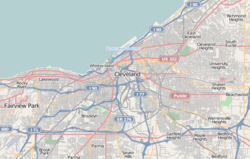Archwood Avenue Historic District facts for kids
Quick facts for kids |
|
|
Archwood Avenue Historic District
|
|

The Oscar Kroehle House
|
|
| Location | Archwood Ave. roughly bounded by W. Thirty-first Pl. and W. Thirty-seventh St., Cleveland, Ohio |
|---|---|
| Area | 13 acres (5.3 ha) |
| Architectural style | Colonial Revival, Italianate, Queen Anne |
| MPS | Brooklyn Centre MRA |
| NRHP reference No. | 87000428 |
| Added to NRHP | March 19, 1987 |
The Archwood Avenue Historic District is a special area with old homes in the Brooklyn Centre neighborhood of Cleveland, Ohio. These houses were built around the early 1900s. Archwood Avenue has been an important street since it started. It became a historic district in 1987.
Contents
What is the Archwood Avenue Historic District?
This historic district is a neighborhood filled with beautiful old houses. It shows how people lived and built homes a long time ago. The district is in the Brooklyn Centre part of Cleveland, Ohio. It's a great example of history you can see every day.
A Look Back: How Archwood Avenue Began
When the area called South Brooklyn was first planned, Archwood Avenue was one of its main streets. The land lots here were bigger than on other streets. Also, the street itself was wider than usual. Because of this, the largest and most important houses in the village were built along Archwood Avenue.
In 1894, South Brooklyn became part of Cleveland. It was then called the Old Brooklyn neighborhood. Even after this change, Archwood Avenue kept its important place. It remained a key street with many grand homes.
Cool House Styles You'll Find
The houses in the Archwood Avenue Historic District show different building styles. You can see styles from the late 1800s and early 1900s. These include Colonial Revival, Italianate, and Queen Anne.
What's interesting is that these styles are all mixed together. You won't find one style in just one part of the street. For example, on one block, you might see an Italianate house right next to two Queen Anne houses. This mix makes the district very unique.
Famous Homes in the District
Some houses in the district are especially famous. These are considered the best examples of the architecture there. They include the William Coates, Weldon Davis, Oscar Kroehle, Adam Poe, and Charles Selzer Houses.
There are also two apartment buildings that stand out. They are located at the intersection of 33rd Street. These buildings have two different fronts and fancy entrances.
Why is it a Historic District?
In 1987, Archwood Avenue was officially named a historic district. It was also added to the National Register of Historic Places. This happened because the old buildings there were still in great shape. They showed their original design and history very well.
The district covers about 13 acres (about 5 hectares). It includes 57 different buildings. All of these buildings were considered important enough to be part of the historic district.




